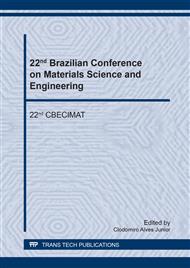p.73
p.79
p.85
p.90
p.95
p.101
p.107
p.115
p.120
Analysis of Europium Doped Strontium Aluminate Synthesized by Route of PVA Evaporation
Abstract:
In this work strontium aluminate doped with trivalent europium ion was prepared by the method of evaporation of poly vinyl alcohol and their luminescence, structural and thermal properties were investigated. The samples were characterized by thermal differential and thermogravimetry analysis, structural analysis was performed by X-ray diffraction and Fourier transform infrared spectroscopy and luminescence by fluorescence emission spectroscopy. The thermal analysis of aluminate samples showed two mass losses accompanied by endothermic and exothermic processes during the calcination process, not depending on the time employed in calcination. The infrared spectra exhibited characteristic bands of the metals involved in the synthesis of the material demonstrating the formation of strontium aluminate. The diffratogram patterns showed the formation of cubic phase Sr3Al2O6. The fluorescence characterization showed two emission bands attributed to matrix and europium excited states and it was observed that as the calcination time and temperature were increased, the emission of europium in the material was less efficient.
Info:
Periodical:
Pages:
95-100
Citation:
Online since:
September 2018
Price:
Сopyright:
© 2018 Trans Tech Publications Ltd. All Rights Reserved
Share:
Citation:


